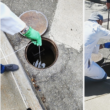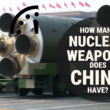Testing Bioweapons: the Catch-22
By Martin Furmanski, March 30, 2015
In his posting for this roundtable, Seth Baum asked for a further discussion of several issues: one was the impact of technological advances, another how dismantling the Biological Weapons Convention might threaten global catastrophe.
No matter what technical advances may develop, biological weapons are fundamentally different from conventional, chemical, and nuclear weapons, because they depend upon species-specific biological characteristics, rather than broad phylum-specific biological processes affected by chemical weapons or physical and radiological effects. Bioweapon agents are fragile compared to other weapons, subject to rapid degradation during dispersion. This means candidate bioweapons must be tested on humans, and in the open air.
Scientists, quite naturally, are accustomed to drawing conclusions based on laboratory tests performed in defined, highly constrained systems where variables are controlled or excluded; this is, after all, the scientific experimental method. It is a mistake, however, to assume that laboratory tests alone can insure the development of effective bioweapons.
The US and UK offensive bioweapons program found repeatedly that laboratory tests were fraught with pitfalls and were insufficient alone to predict the behavior of bioweapons.
Bioweapon aerosols must traverse the open air. In 1946, at the remote Suffield proving ground in Canada, bioweapon scientists were chagrined to find that after relatively short downwind travel, bioweapon agents, though viable in laboratory cultures collected downwind, were unable to cause infection in exposed animals. Dealing with this “infectivity/viability dissociation” became a central focus of the US bioweapons program. Major technical installations, including the million-liter “8-ball” sphere at Camp Detrick, were constructed to allow the release of BW agents in controlled conditions and to sample the results at various post-dispersal intervals. Side-by-side exposures of human subjects (see below), non-human primates and other laboratory animals were made. Eventually open-air “proof tests” of biological agents produced downwind infections at the isolated Dugway Proving Ground in Utah and in the open Pacific Ocean off Johnston Island.
The utility of these proof tests was largely invalidated when in the late 1960s workers at Porton Down in the UK found that bacteria and viruses, including bioweapon pathogens, when exposed to outdoor air in a bio-secure apparatus sometimes showed episodes of dramatic loss of viability compared to their survival in closed containers. This was termed the “open air factor” and was linked temporally to conditions favoring importation of air from distant metropolitan areas. Studies in urban areas showed the open air factor to be ubiquitous and characterized as a synergistic combination of ozone and hydrocarbon fragments (olefins) typical of motor-vehicle associated photochemical smog. Its effect disappeared in confined spaces such as buildings or laboratory apparatuses such as the 8-ball. At concentrations of a few parts per billion, the open air factor was capable of rapidly reducing bacterial and viral viability by several orders of magnitude.
Since weapons of strategic deterrence would target urban areas, the existence of the open air factor would seem to deal a fatal blow to most bioweapon agents as candidate deterrent weapons. It also emphasizes that even elaborate, expensive laboratory investigations and field tests in isolated areas cannot model effectiveness in combat conditions.
A valid human dose-response curve with a “downwind” infectivity profile is essential to calculating design and targeting protocols for the strategic deterrent bioweapons Baum proposes. The US program acquired this data by exposing humans to bioweapon agents (with the 8-ball, for example), but with an important Catch-22. The agents so used had to be amenable to rapid and reliable cure with specific therapy. This meant that these agents were of limited lethality: tularemia, typically characterized as “potentially lethal” by bioweapon advocates, had only a two to seven percent fatality rate if untreated, and nil if treated with common antibiotics.
Experimentation on humans is fraught with ethical pitfalls and has a disgraceful history. Bioweapon programs are no exception. Most egregious was the Japanese program of 1935 to 1945, which used human captives almost to the exclusion of laboratory animals. At least 3,000 captives, and likely several fold more, perished in ultimately fatal experiments.
The US program’s human experiments in the 1950s and 1960s would not be ethically acceptable today. In 1957, a university hospital was contracted to determine the infective dose of tularemia, and it intentionally infected “members of our staff or suitable volunteer patients from the wards of the medical service.” An Army mobile lab determined the inhalation dose/response curves of bioweapon agents by using “volunteer” prisoners. Intensive studies were run on approximately 2,300 Operation Whitecoat volunteers, who were conscripted Seventh-day Adventist conscientious objectors. These vulnerable populations are excluded from human studies today.
So if non-contagious lethal biological weapons are legitimized, how are the essential human tests to be accomplished? Intentional exposure to untreatable lethal bioweapon agents would clearly fail ethical standards and would hardly attract many volunteers, unless participation were considered religious martyrdom. Covert testing on unwilling “disappeared” humans at “dark” sites is a chilling possibility and tragically not very farfetched, even for democracies, given the recent experience with torture.
Baum asks, apparently seriously, how the exit by nuclear powers from the Biological Weapons Convention by could result in proliferation of bioweapons. I will allow another participant to address the political aspects of this rather obvious consequence of his proposal. Of course many non-nuclear nations would be motivated to at least try to develop bioweapons.
The trying is more of an issue than the chances of success. The risks of escape from laboratories of dangerous pathogens and the risks of developing new strains with “gain of function” capabilities is currently of great concern. (See
"Threatened pandemics and laboratory escapes: Self-fulfilling prophecies.") These risks would only increase as classified bioweapon labs proliferated without inspection or accountability. There is no guarantee that any nation, once committed to develop a bioweapon capability, would necessarily comply with Baum’s arbitrary restriction of avoiding contagious pathogens. And as Baum acknowledges, release of contagious bioweapon agents, intentional or accidental, would be a grave threat indeed.
One must remember the failure of the elaborate technical apparatus of the US bioweapons program to predict the real world effects of candidate bioweapons was the result of stringent constraints on release of agents into the environment and a real (if flawed in retrospect) commitment to the protection of the human test subjects, bystanding civilians, and military personnel.
A pariah state or well-funded extra-national organization that felt no such constraints could avoid the trouble and expense of laboratory studies and just fashion “best guess” candidate bioweapons, release them on “enemy” territory (or less provocatively, on some neutral territory), and watch the results. The Assad regime’s use of improvised chemical weapons on its own rebellious citizens exemplifies this risk. Even nominally responsible nations could perform deniable, untraceable field tests using anonymous releases. And if a nuclear-armed nation were to receive such an attack, it might well consider it a threat to its national survival (or the sentinel wave of an emerging bioweapons attack that would) and mount a nuclear response against the presumed perpetrator.
Hello nuclear winter.
Share: [addthis tool="addthis_inline_share_toolbox"]














